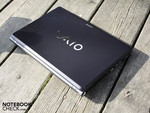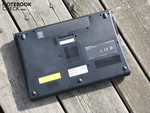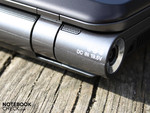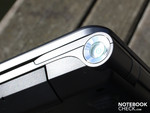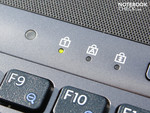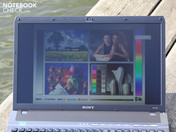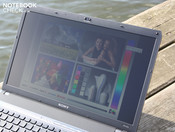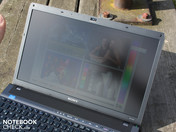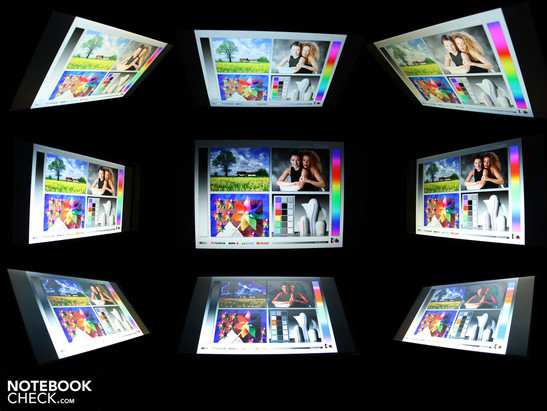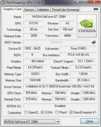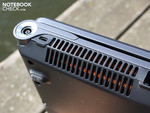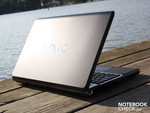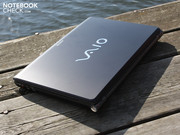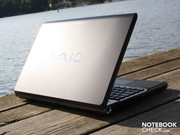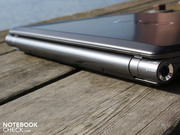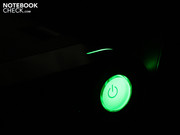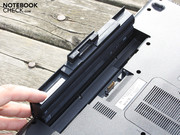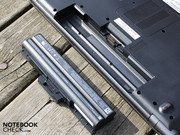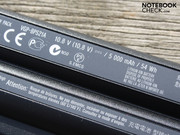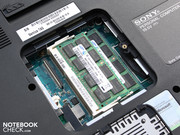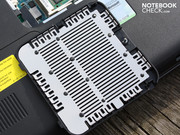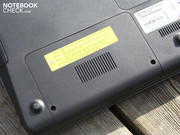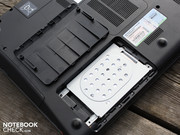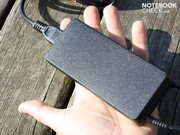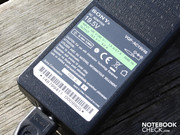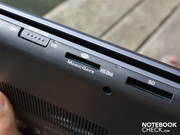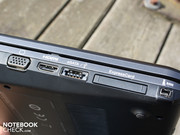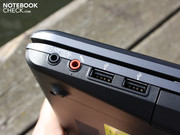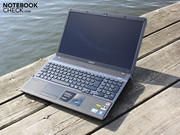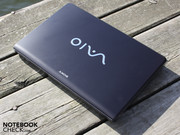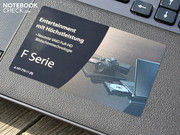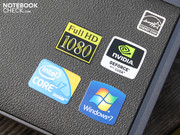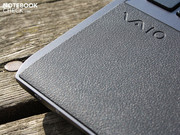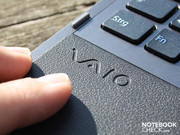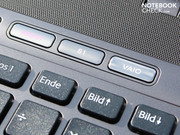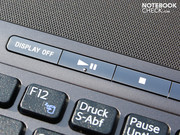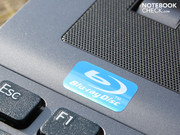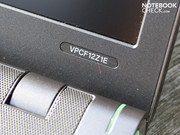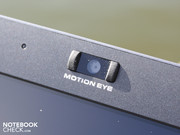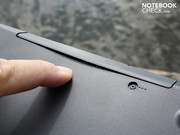Review Sony Vaio VPC-F12Z Notebook

Sony's F-models address professional users and demanding private users who need a strong notebook for editing video, audio and picture material. Thus, the notebooks don't only have a first-rate, matt FullHD display (all models anti-glare, except for VPCF11M1E/H), but also a potent Core i5 or i7 processor. Our test device VPCF12Z1E/BI is the shooting star of the series with the strong quad core, i7-740QM (4x1.73 GHz).
As such, the 16.4 incher has a proud price. It's found in retail starting at 1530 euro. The least expensive model, VPCF11M1E/H in titanium gray, is already available for starting at 999 euro. However, it doesn't have an AR coated display.
We want to find out if the i7-740QM alternative (VPCF12Z1E/BI) differs significantly from our first test model, with a 720QM (VPC-F11Z1/E) in terms of performance in this review. We also want to know if the criticized, because loud fan management, has changed for the better.
Case
A 16.4 incher usually isn't designed for a long-term transportation. However, the Vaio F12 has many construction features that can also manage such a use. We can only twist the base unit marginally with both hands by applying force. The base plate exposes smooth plastic. The surfaces are stable almost everywhere here too, with exception of the area underneath the optical drive. It can be depressed without difficulty.
The matt and insensitive case surfaces allow it to survive the odd transportation. The closed lid is kept tight on the base unit and can't open by itself. Small objects can't slip in and damage the screen because the TFT edge lies tight on the case.
Wrist-rest and touchpad prove to be solid. We can only dent the left area with a bit of force. The surface is covered with the same imitation leather that also adorns Sony's professional SLR cameras. Our hands feel very comfortable on the slip-resistant and wide surface. The haptics make a very high-end impression with this material.
On the other hand, the Vaio F12 is very heavy with 3118 grams and the bulky size doesn't fit in every backpack. The correlating adapter isn't a light-weight either with almost 400 grams. Something strikes us here: Sony includes a lighter and smaller adapter (VGP-AC19V46 120 watts). Our first test device, F11Z1/E, was equipped with a 534 gram heavy VGP-AC19V16 120W.
The hinges keep the heavy lid firmly in place and don't allow it to teeter. The maximum opening angle of circa 140 degrees is sufficient for a use on the lap. The F12Z1E owner only needs one hand to open it, although the hinges are quite stiff. The heavy base unit keeps itself down.
Connectivity
A multimedia machine wouldn't be one if it skimped with connections. The F12 has almost the complete lineup of current ports. We find a HDMI-out, beside Ethernet and VGA, on the left. A TV set or an external TFT is connected to HDMI, which also transmits the audio signal. If an interface should still be missing, it can be retrofitted via the ExpressCard34 slot. This applies for USB 3.0 or special interfaces or audio cards, for example.
FireWire and eSATA support fast data reception or transmission. A camcorder or even an external hard disk can be connected to the iS400 port (FireWire). eSATA, combined with USB here, can be used for fast communication with external eSATA hard disks. Everyone who works with large pictures or videos will know the value of fast copying.
If you imagine the Vaio F12 equipped with all cabled peripherals, you'll see the inconvenience when a mouse is placed, or at least a cable chaos. Ports on the notebook's rear would likely have been handier for many users. The lid's mounting prevents ports on the rear completely, though. There's unfortunately no real docking stations available for the F Series.
Sony installs two cardreaders to also read Sony Memory Stick HG Duos, aside from the standard SD memory cards. This is sensible, because HG Duo is the memory card format of some digital single lens reflex cameras, high-end digital cameras and digital camcorders.
The webcam is disappointing, though. Whilst the F12 is optimized in every way for high resolutions, the Motion Eye Webcam can only record with 640x480 pixels (VGA, 0.3MP).
It's only consistent that Sony offers a WLAN draft-n (Intel Centrino Advanced-N 6200 AGN) and a gigabit LAN controller (Marvell Yukon 88E8057 PCI-E). Mobiles or even a few inputs can communicate with the Vaio F12 via Bluetooth. An Optiarc BD RW BD-5730S6 is used as the Blu-Ray burner. This abbreviation stands for the maximum of what an optical drive can read and write nowadays.
Input Devices
Keyboard
Sony uses a so-called isolation keyboard. The keys are clearly separated and divided by a crosspiece. This crosspiece is part of the case, whereby the keys can be described as submerged in the case.
The keyboard bids the typist a very distinct pressure point, a large key stroke length and firm stroke. Those are, aside from the generous layout, the most substantial criteria for frequent typists. The key bed fits tight on the entire surface. We can't even force yielding over the optical drive (number pad) with pressure. The manufacturer appears to have made improvements here in comparison to the F11 test device.
The number pad makes it easier to input numbers and to use the calculator. The clearly separated arrow keys are noticed positively. They are a bit smaller, but fingers can find them intuitively.
Touchpad
The mouse replacement is almost even with the wrist-rest. The Alps pad has a matt but relatively smooth surface that gives the finger little scroll resistance. The cursor can be controlled accurately, anyway. The large surface is sensitive up to its edges. The surface has horizontal and vertical scroll bars, even if they aren't optically or haptically marked. It is a multi-touch pad. Multi-finger gestures are thus possible.
Display
The Vaio VPC-F12Z1E's FullHD TFT has a very high resolution of 1920x1080 pixels. The screen (type not identified: "Vaio Premium Display") has an AR-coating. The anti-glare display is set up perfectly for a desktop notebook claim. Additionally, it has high contrasts for color perception in movies and pictures. We determined a black value of 0.39 cd/m2 at maximum brightness. This results in a good contrast of 595:1.
The slight pressure marks on the entire screen surface that are created when the lid is moved are disturbing. The screen seems to be a fixed bit too tight on the lid surface. This effect doesn't show up when used on a desk because the display likely won't be adjusted.
| |||||||||||||||||||||||||
Brightness Distribution: 89 %
Center on Battery: 232 cd/m²
Contrast: 595:1 (Black: 0.39 cd/m²)
The FullHD's backlight lightens up the screen to 232 cd/m2 in the center. The average is 221 cd/m2 and the illumination of 89 percent is very even. The plus of brightness could be vital for use in sunlight.
An ambient light sensor changes the background LEDs' luminosity when enabled. Thus, a sensor adjusts the brightness to the lighting conditions (eye protection, energy savings) and a manual setting via the FN keys isn't necessary. The sensor sets the luminosity to maximum in sunlight. The ambient light sensor was disabled via the Vaio Control Center for the measurements and outdoor pictures.
If you like to carry 3.51 kilograms (including adapter) into the sun, you'll be thrilled about the matt and relatively bright display. There are no reflections and the display is always well legible, at least from the front. Lateral views are however still difficult in intense sunlight. The display turns too dark to work on it without much effort under certain circumstances.
Good viewing angles are mandatory for a multimedia notebook with a high-end claim. Many pairs of eyes often look onto the display during use, and everyone wants to have a good view at the same time. The horizontal viewing angles don't have anything to be ashamed of. There are almost no color falsifications, even when we look onto the display at 80 degrees (far right/left).
The view may only deviate up to about 20 degrees on the vertical plane (up, down) before the colors start to falsify. A picture is still well seen as such at 70 degrees upwards, as the display doesn't dim. That doesn't work downwards. The viewer experiences extremely inverted colors on the intensely dimmed screen already at 20 degrees. The Vaio VPC-F12Z1E/BI can't provide the color stability of a good desktop TFT (colors stay constant from all positions).
Performance
The strong quad-core processor, Intel Core i7-740QM, has a relatively low basic clock rate (1.73 GHz) but a high turbo rate (2.93 GHz). It has a 256 KB Level 1 cache and a 6 MB Level 3 cache. The TDP is, alike the sister model 720QM (4 x 1.60 GHz, Turbo 2.8 GHz), 45 watts.
As the i5 processors, the i7s have Intel's Turbo Boost. That means a dynamic overclocking depending on application requirement. The single processor cores are overclocked fully automatically. This way, applications always have the momentarily necessary capacity available. Thus, the old discussion about multi or single core applications isn't any longer important. Both application types are simply supplied perfectly.
Moreover, there is hyperthreading. This feature complements the four physical cores with four virtual threads. Therefore, applications can compute up to eight threads. In this case, not all eight clock with the aforementioned 2.93 GH7 (that would burst the TDP limits), but rather with 1.9 GHz. Only when one core takes over the entire calculation effort does its clock rate increase to the maximum of 2.93 GHz. This isn't common in reality, because some background programs are always being processed by other threads.
The system is supported by an 8 GB DDR3 RAM (PC3-10700, 1333 MHz). This memory type provides for a very good memory score of 3911 points in PCMark Vantage. The 8 GBs is on two RAM slots, which are furnished with these. The 64 bit operating system, Windows 7 Home Premium, can manage this large memory capacity.
The 740QM will compute faster than its sister model, 720QM, due to the higher basic clock rate (1.73 instead of 1.6 GHz) and the higher turbo rate (2.93 instead of 2.8 GHz). But will it be a major difference?
The multi-core benchmark, Cinebench R11.5, uses all threads: 3.16 points. Systems with a 720QM reach 2.6 to 3.0 points. The 740QM ends the classic benchmark, WPrime 1024m, ends the after 434 seconds. The Vaio VPC-F11Z1/E needs 492 seconds, so 12 percent more time. This performance boost runs through all multi-core CPU benchmarks. It's 10 percent in comparison to the previous VPC-F11Z1/E in Cinebench R10 Multi 64 bit.
The single core benefit isn't as large. Cinebench R10 Single 64bit finishes with 3780 points. The VPC-F11Z1/E with a 720QM reaches 3732 points (-1.5 percent). The differences of SuperPi 32m in comparison to other 720QM systems are equally minor: 807 versus 834 seconds (-3 percent).
| PCMark 05 Standard | 6675 points | |
| PCMark Vantage Result | 5942 points | |
Help | ||
The benefit of multi-core computing should have a positive effect on the system's overall performance because PCMark05 and PCMark Vantage just love many computer cores: 5942 vs. 5844 points. This is merely an increase of two percent. The older PCMark05 even rewards our test device with a score that is slightly lower than that of 720QM systems: 6675 points. We unfortunately don't have a rating for the Vaio VPC-F11Z1/E for this.
Judging from the system benchmarks, it seems as though it's not worth investing in a quad core 740QM- A look at our benchmark chart even goes beyond that and shows that almost all our i5-520M notebooks achieve a better PCMark Vantage rating. For example, HP's Envy 14-1010eg (Radeon HD 5650, 6.914 points); Toshiba's Tecra S11-11H (Quadro NVS 2100M, 6.411 points); Sony's Vaio VPC-B11V9EB (Intel HD, 6.180 points). Many applications seem to like the higher basic clock rate of 2.4 GHz better than eight threads with 1.73 GHz.
In regards to these figures, you should consider that the PCMark Vantage score isn't only based on the CPU, but also includes the performance of HDD, memory and GPU.
| 3DMark 03 Standard | 19346 points | |
| 3DMark 05 Standard | 13414 points | |
| 3DMark 06 Standard Score | 6574 points | |
| 3DMark Vantage P Result | 2800 points | |
Help | ||
A Seagate 7200 rpm hard disk (ST9500420AS) is built into the Vaio VPC-F12Z1E. The Seagate Momentus, with a capacity of 500 GB, reads data with 72 MB/s from the rotating disks in sequential read. But this is a normal rate for a 7200 rpm HDD, no optimum. Standard, slow rotating 2.5 inch notebook hard disks are in a range of 60 to 65 MB/s.
The HDD's write and read heads aren't audible during use. A second hard disk in Raid 0 would have been perfect for a use as an editing studio for videos or animations. This would have allowed the system performance to skyrocket due to faster accessing, as our test device, Vaio VPC-Z12 (2 x 64 GB SSD RAID 0), proved exemplary in a recent review.
An Nvidia GeForce GT 330M with a 1024 MB DDR3 memory is built in as the GPU. The core clocks with 575 GHz, and the memory with 790 MHz. Nothing has changed in this regard in comparison to the VPC-F11Z1/E. The graphic card benchmark, 3DMark2006, closes with 6574 points. This is identical to the VPC-F11Z1/E (720QM) and is a typical result for the midrange GPU, whereas the CPU boosts the result a bit (Samsung R580 Hawk, i5-520M, 6.412 points).
But what about the real i7-740QM + GT-330M combination's gaming power? We've often reproached this Nvidia GPU in the past because it was weaker than the usually less expensive ATI HD 5650. The gaming tests will show if the 740QM can change this.
StarCraft 2
Blizzard puts moderate demands on the 3D hardware in its sequel, which is why high details are possible even with midrange GPUs. Our GT330M draws 30 fps out of the hardware (28 fps with HD 5650 & i5-430M, Acer TravelMate 7740G-434G50Mnss). The quad-core processor really does help get a few more frames. Samsung's NP-R590-JS0YDE (i5-450M, GT 330M) only achieves 26.5 fps.
| StarCraft 2 | |||
| Resolution | Settings | Value | |
| 1920x1080 | ultra | 16 fps | |
| 1360x768 | high | 29.7 fps | |
| 1360x768 | medium | 39.3 fps | |
| 1024x768 | low | 171 fps | |
Mafia 2
The quad advantage seems to only be apparent in strategy games (many small units, CPU calculation). Our GT 330M notebooks are on par in the Mafia II epic: High 32 versus 31 fps (Samsung R590 versus Vaio F12). Be that as it may, the gangsters' shootouts can be enjoyed in high details. A HD 5650 (Acer TravelMate 7740G-434G50Mnss, i5-430M) can however inherit more frames (high 37 fps).
| Mafia 2 | |||
| Resolution | Settings | Value | |
| 1920x1080 | high, 0xAA, 16xAF | 19 fps | |
| 1360x768 | high, 0xAA, 16xAF | 31.1 fps | |
| 1024x768 | medium, 0xAA, 8xAF | 37.6 fps | |
| 800x600 | low, 0xAA, 0xAF | 46.6 fps | |
Gaming Verdict
A small excursion in the World of Games shows that the GT 330M is only just suitable for current games with medium to increased demands on the hardware. Real time strategies with many CPU calculations appear to benefit from quad-cores. Nevertheless, the Vaio F12 isn't the perfect gamer. The HD 5650 that is already found in notebooks starting at 650 euro lets frames run faster - even with weaker CPUs.
| low | med. | high | ultra | |
|---|---|---|---|---|
| StarCraft 2 (2010) | 171 | 39.3 | 29.7 | 16 |
| Mafia 2 (2010) | 46.6 | 37.6 | 31.1 | 19 |
Emissions
System Noise
The fan isn't as erratic, but the droning noise has stayed. We would describe the differences between the criticized VPC-F11Z1/E (test device in February 2010) and the VPC-F12Z1E at hand.
The noises are still the only major weak points of the Vaio VPC-F12Z1E. But we wouldn't expect a whisper-quiet operating from a quad-core processor. We would already be satisfied if the fan only would rotate consistently. But that's not the way it is. The cooling changes its speed audibly, even in idle, and emits a high pitched droning sound starting at medium rotation speeds. This mechanical vibration isn't measurable but audible and annoying. The difference to the test device we first tested in February 2010 is that the revolution rates don't change as erratically, but a bit "softer" instead.
Due to the fluctuations, the idle system noise is between 33.1 and 35.1 db(A), which is quite a large difference. The fan works most quietly when the "balanced" mode is selected in the Vaio settings. The fan doesn't get louder and more constant as hoped in the "performance" mode, but more erratic with higher maximum rates.
Now, we'll put the F12Z1E under constant load. The system noise increases up to 47.1 dB(A) in our gaming benchmarks. Just like for the gaming test, this applies to 3DMark 2006. The fluctuations from idle remains, but now on a higher speed level.
The stress test (GPU + CPU) of several hours draws out the maximum: 48.8 dB(A). We experience a restless up and down revving in their revolution speeds for all load states and their soundscape.
Noise level
| Idle |
| 33.1 / 33.4 / 35.1 dB(A) |
| HDD |
| 33.1 dB(A) |
| DVD |
| 34.7 / dB(A) |
| Load |
| 47.1 / 48.4 dB(A) |
 | ||
30 dB silent 40 dB(A) audible 50 dB(A) loud |
||
min: | ||
Temperature
At least the fan's inexhaustible performance has an advantage. The base unit stays very cool in idle and acceptable under load. We measured 40.1 degrees Celsius on the touchpad in the stress test for processor and graphic card. The base plate can present higher temperatures and selectively climbs to 44 degrees (vent vicinity). However, the average is only 31.5 degrees due to the otherwise cool surfaces.
The Vaio VPC-F12Z1E stays very cool during the idle scenario. The previously warmest area on the base plate is now only 28.5 degrees. The work surface average is 27 degrees.
The processor didn't exceed the core temperature of 84 degrees (GPU 74 degrees) during the stress test. The stress test didn't have an impact on the component's performance (thermal throttling). 3DMark06, executed immediately afterwards, achieved 6570 points (normal 6575 points).
(±) The maximum temperature on the upper side is 40.1 °C / 104 F, compared to the average of 36.9 °C / 98 F, ranging from 21.1 to 71 °C for the class Multimedia.
(±) The bottom heats up to a maximum of 43.8 °C / 111 F, compared to the average of 39.2 °C / 103 F
(+) In idle usage, the average temperature for the upper side is 27.1 °C / 81 F, compared to the device average of 31.3 °C / 88 F.
(-) The palmrests and touchpad can get very hot to the touch with a maximum of 40.1 °C / 104.2 F.
(-) The average temperature of the palmrest area of similar devices was 28.7 °C / 83.7 F (-11.4 °C / -20.5 F).
Loudspeakers
The stereo loudspeakers above the keyboard don't live up to our expectations set on a high-end multimedia notebook. Our ears miss clear low ranges and basses. The small membranes can't create these though, and there is no subwoofer. Thus we can only describe the sound as midrange-prone. The sound quality is far from that what sound potent notebooks, like MSI's FX600 (four loudspeakers) or Asus' N71JV (2.1 system, viz. stereo plus subwoofer) have to offer.
Playing around with sound enhancements doesn't improve the sound either. The Dolby Audio Enhancer and the Dolby Virtual Surround should remain enabled in any case. If you disable them, you'll experience inappropriate trebles in the sound.
An external sound system can help here. But it can only be connected to the headphone-out. Analog headphone and SPDIF are combined in the notebook. The output level is, in unison with the low maximum volume, low but static free.
Battery Life
The battery life with the quad-core CPU isn't the Vaio F12's strength. No matter if it's the idle, WLAN, DVD or Blu-Ray runtime, they all turn out low. This might be due to the 54 watt hour battery (5000 mAh). This relatively low capacity is faced with a high power requirement of at least 20 watts (see the following).
The WLAN surf session already comes to an end after 1:49 hours (109 minutes). If you are frugal and only edit a few documents, you can end up with 2:38 hours with disabled WLAN/Bluetooth. We determined these maximum runtimes with the BatteryEater Reader's test. The display's brightness was set to the lowest level for this test. A Blu-Ray or DVD movie doesn't make much of a difference. The test established a weak 90, respectively 95 minutes (luminosity 100 cd/m2).
The short battery runtimes indicate a high power consumption and our multimeter also proved that. The test device needs a minimum of 20.5 watts (idle, maximum energy savings). The 720QM sister model was a bit more economizing with 17.9 watts. The processor clocks down to 929 MHz in energy saving or balanced profile.
The CPU doesn't downclock in an idle scenario with high performance mode (1730 MHz) and makes the power consumption climb to 39.4 watts. If the Core i7-740QM and GT 330M now compute with full power (stress test), the effective power increases to 111 watts. Such a high power consumption isn't even achieved in 3D games, which is shown by the measurement during a 3DMark06 run: 84.3 watts. The 120 watt adapter supplies adequate power in view of the maximum possible consumption.
| Off / Standby | |
| Idle | |
| Load |
|
Key:
min: | |
Verdict
The Vaio VPC-F12Z1E/BI is the F Series' strongest model and comes with an Intel Core i7 quad core CPU i7-740QM. The combination with Nvidia's GeForce GT 330M doesn't make the 16.4 incher to a gaming machine, but a strong work device for processing digital multimedia contents.
There is almost everything needed for connecting receivers or fast memory devices with HDMI, eSATA, SPDIF and FireWire. A Blu-Ray burner shouldn't be left out in this alignment. The RAM has a capacity of 8192 MB and interfaces or devices can be retrofitted via ExpressCard 34.
The contrast rich FullHD display with its very stable horizontal viewing angles and the good brightness is praiseworthy. The TFT is AR coated and is also suitable for use in sunlight. Routine typing tasks are easily accomplished with the solid and clearly arranged inputs. The high-end leather application on the wrist-rest won't only inspire photo fans.
The cooling system remains to be a drawback of our test device. It keeps the temperatures low, but does its cooling job erratically and is inflicted with interferences. A disadvantage, but less crucial for the heavy 16.4 incher's purpose, are the short battery runtimes (WLAN surfing 1:49 minutes). They correlate to the thigh idle power consumption (20 to 40 watts).
The Vaio F12 is suitable for ambitioned power users who want to work seriously with a fairly portable notebook. If you are used to loud PCs, you could even get used to the disturbing fan.
The Vaio F is available with Core i5-520M, but with a glare type screen (FullHD) starting at 999 euro (VPCF11M1E/H). The GeForce GT 330M is common for all F12 alternatives. Components like RAM or Blu-Ray burner are variable.




